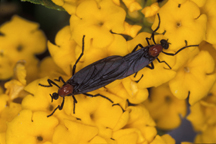UF/IFAS News Release
 | 05.27.2004 Fact Or Fiction? The Truth About Those Pesky Lovebugs
|
|
GAINESVILLE, Fla.---Fact or fiction? Sometime in the 1950s an experiment gone horribly wrong at the University of Florida produced a pesky bug with no apparent purpose. The strange-looking insect — commonly known as the lovebug — managed to escape from researchers and began to spread rapidly, wreaking havoc on people and cars. "Although most people have heard, or told, this story in some form or another, it's just not true," said Thomas Fasulo, an extension entomologist with UF's Institute of Food and Agricultural Sciences.
"I started hearing this story in 1979, my first year as an entomologist in Florida, but other entomologists told me they heard the same story long before that," Fasulo said. "How it got started we just don't know." The lovebug, which is actually a fly whose scientific name is Plecia nearctica, migrated naturally along the Gulf of Mexico, Fasulo said. It was first identified in southeastern Texas in 1940 and has since spread through the Gulf Coast states of Louisiana, Mississippi, Alabama and Florida, as well as Georgia and South Carolina. Fasulo said there are two generations of lovebugs each year, and large adult populations are present during May and September. These populations last about four weeks, although researchers have seen them throughout the year. Most people notice lovebugs during these times of the year when they have to wash them off their cars, or slap them aside when sitting outdoors. "It's only during these two months that people ask where these insects came from," Fasulo said. "The rest of the year they're actually beneficial for the environment." Lovebugs help the environment when they are in their immature stage, Fasulo said. When grass is cut and the excess falls to the ground, it creates a covering known as thatch, where immature lovebugs live and eat. Through this process they redistribute essential nutrients back into the ground that are beneficial to plants and the environment. He said researchers have found that automobile exhaust fumes, heat from the engines and the vibrations of the vehicles themselves all attract lovebugs that splatter against the fronts of cars. The results can be nasty, causing cars to overheat, reducing driver visibility and damaging paint on vehicles. Fasulo recommends washing cars within one day to reduce paint damage, and he suggests using a hood deflector or screen to help protect the paint. As for lovebugs looking strange when flying together attached, they are actually mating. During the mating process, the male lovebug attaches to the female lovebug and only disengages during the daytime while resting on vegetation never during flight or at night, Fasulo said. Successful mating takes as much as 12 hours, and the female lovebug dies within 86 hours of laying eggs. Although there are no chemical controls for lovebug populations, some natural controls do exist. These include natural predators, a low amount of rainfall, as well as several types of fungi that influence mortality rate upon ingestion. For more information, see the Featured Creatures publication on the lovebug at http://entomology.ifas.ufl.edu/creatures/misc/lovebug.htm . |
UF/IFAS News is available at http://news.ifas.ufl.edu/
All news stories and associated media (photographs, video, and audio) are for editorial use only. Any commercial use is strictly prohibited.